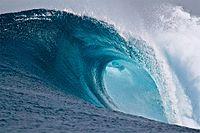
Photo from wikipedia
Based on the balance between the scattering force and the trapping force of an evanescent field of a standing wave on silicon waveguides, we propose a structure for controllable trapping… Click to show full abstract
Based on the balance between the scattering force and the trapping force of an evanescent field of a standing wave on silicon waveguides, we propose a structure for controllable trapping and releasing of nanoparticles, which can act as pause operation for nanoparticle flow control. The design is realized by the cascade of an optical switch with a structure of a ring-assisted Mach-Zehnder interferometer (RAMZI) and a Sagnac loop reflector which connects to one output of the switch. Through thermal tuning, with a tiny refractive index change of 4.3×10-4 on a ring resonator, the output of a RAMZI can be switched between two ports. As for the release state of the nanoparticle flow, the light is guided to the port without a reflector. There is no standing wave or traps formed on a waveguide. Therefore, the scattering force dominates, which drives particles moving forward to output ports. Otherwise, for trapping a state, the light will be reflected by the Sagnac loop and form a stationary standing wave which provides an array of traps for nanoparticles. Most importantly, the structure can switch its state to trap or sequentially release particles without losing the control of samples which, to the best of our knowledge, has not been realized before. With the statistical description of particle motion, the balance between trapping and releasing is distinguished by the trapping time and tuned by reflectance. The feasibility of our design is verified using the three-dimensional finite-difference time domain and Maxwell stress tensor methods. Our structure possesses the merits of high compactness and time effectiveness and, thereby, it is highly suitable for on-chip optical manipulation of nanoparticle flow control, which brings great potential in integrated on-chip optofluidics.
Journal Title: Optics letters
Year Published: 2018
Link to full text (if available)
Share on Social Media: Sign Up to like & get
recommendations!